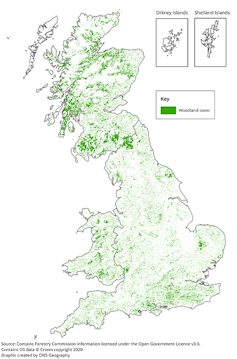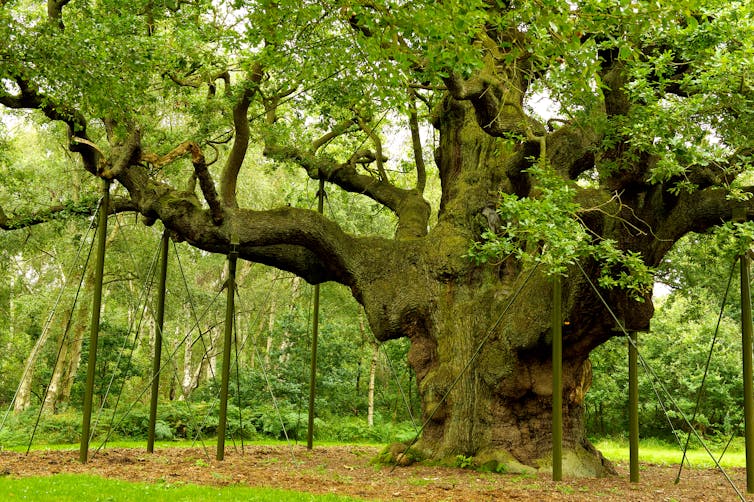
The UK has a strange relationship with its woodlands. Trees and woods form part of the national identity, yet with only about 13% tree cover, it is one of the least wooded countries in Europe.
Ancient woodland – defined as those areas that have been continuously wooded since the year 1600 in England and Wales and 1750 in Scotland – is the UK’s most biodiverse woodland habitat type, and the best at storing carbon, yet only covers 2.5% of the UK’s land area. The trees might be old, but it is the undisturbed soil that gives the designation “ancient” and which allows rare plants and animals to flourish.
However, these remnant ancient woodlands are under constant threat. The Woodland Trust has recorded almost 1,000 ancient woods damaged or permanently lost since it began tracking them in 1999. Only 7% of the UK’s woodlands are in a state of ecological health.

This woeful picture seems at odds with the fact that native deciduous species, such as oak, run through the UK’s sense of nationhood. Quercus robur is boldly given the common name “English Oak”, for instance, despite the tree being native to most of Europe. And fabled “wildwoods”, the woodlands which spread after the retreat of the ice sheets at the end of the last ice age, are fixed in the imagination as “natural” woodscape.
This odd relationship, of simultaneously adoring and denuding woodlands perhaps comes from a millennia-long history of managing and using woods for their timber.
The woods that built Britain
It is extremely unlikely that there is a single patch of woodland left in the UK that has not, at some point in its history, been managed by humans for resources. When we look through the gnarled trunks of an area of ancient woodland now, we are looking back in time, through vital hunting grounds, to periods when the trees were managed to supply the English navy with ship building materials.

In early medieval times, these woodlands were highly prized, and largely under crown ownership. They would have been managed by pollarding and coppicing. Pollarding involves regularly felling the top of the tree so that new shoots grow, producing small timber, fuel and feed for animals.
The regular cutting promotes branch rejuvenation such that pollarded oaks reach a great age – if you see an old tree with multiple large trunks, it was probably pollarded. Coppicing is a similar process but the cuts are made back to the ground level.
But big naval powers relied on wooden ships, and ships were becoming bigger. In 1510 it took around 600 oaks to build the Mary Rose, the pride of Henry VIII’s fleet, but 150 years later it took 5,500 oaks to build HMS Victory. This meant the Royal Navy began to demand more wood, including oak trees with longer and straighter trunks, and oak forests came to be primarily managed for this sort of timber.
In 1698, an act of parliament made it illegal to pollard trees in royal forests. Naval surveyors would visit woodlands and leave the “kings mark”, an arrow etched into the trunk of any suitable tree.
It is precisely this managed history that makes remaining fragments of ancient woodland so important today. The UK is thought to be home to more very old oaks than the whole of the rest of Europe, and these trees, which are likely to have been pollarded or coppiced in the past, contain rot holes and decaying wood along with living tissue and so provide a variety of habitats.
Ancient oaks support more than 2,000 associated species including 600 which depend heavily on oak alone. This is why ancient woodland is defined in government planning guidance as an irreplaceable habitat.
Future forests
The government is targeting 16.5% woodland cover in England by 2050 (it’s currently 12.8%). But that target is already below what’s needed to meet climate goals, and does not prioritise natural woodland over monoculture plantations of non-native trees.
It’s not easy to achieve a woodland cover target while also restoring nature, hitting climate targets, and supporting the needs of the timber industry. Getting woodland planting right requires the right policy and legislation, nursery stocks of appropriate tree species, and many more foresters (the government has launched free forestry courses to address a skills shortage).
The UK is currently planting around 3,300 hectares (33km²) of woodland per year. Woodland cover of 16.5% by 2050 would require three times more: 10,000 hectares (100km²) per year.
If given space to regenerate, the UK’s woodlands can help address the triple challenge of averting dangerous climate change, while restoring nature and securing the wellbeing and prosperity of a growing population.
Yet the biggest risk comes from a rush to plant new trees without first protecting those woodlands that remain, and without considering what types of woodland will offer nature the best chance to thrive.
Mary Gagen works for Swansea University and is on secondment to WW UK.
This article was originally published on The Conversation. Read the original article.







